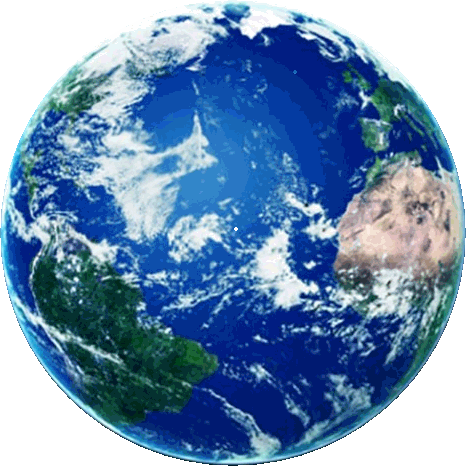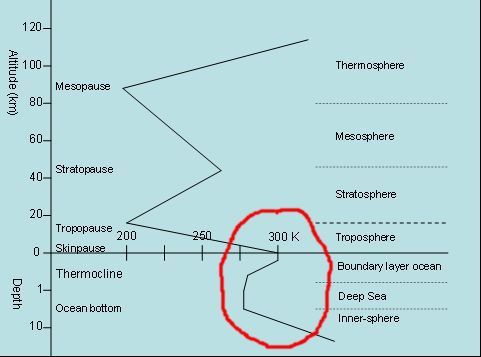|
|

Intro
Een transparant medium gedraagt zich in een stralingsveld anders dan een ondoorzichtig. Dat is voor het klimaat belangrijk. 70% van het aardoppervlak is oceaan. Dat is net als de atmosfeer een transparant medium, dus reden om transparantie nader te bezien. De warmte inhoud van de oceaan is beduidend groter dan van de atmosfeer.
Talloze verhandelingen over klimaat gaan impliciet uit van een ondoorzichtige aarde. Of dat terecht is, zou moeten blijken. In beide voorgaande artikelen
in deze serie en hier
staat aanleiding tot twijfel.
Eerder al bleek een andere belangrijke aanname in genoemde verhandelingen ondeugdelijk. De atmosferische broeikas zou de 30
°C verschil overbruggen tussen de gemeten temperatuur en die van een atmosfeervrije aarde. Dat is onjuist. Het verschil is groter. Dus indien de broeikas het bewerkstelligt, moet hij sterker zijn dan men aanneemt. Dan is hij niet goed uitgerekend. Waren die berekeningen wel goed, dan is er een ander mechanisme dat helpt de aarde leefbaar te houden. Roy W. Spencer, een bekend klimatoloog, gaf aan dat de 30 °C - hij schrijft 33 °C, het verschil is hier niet van belang - eenvoudig het verschil is tussen het veronderstelde stralingsevenwicht en de gemeten temperatuur. Hij bekritiseert de te lage schatting van het te overbruggen verschil. Volgens hem is dat verschil ~60 °C. Maar zijn verklaring voor de lagere evenwichtemperatuur is anders dan die van de onvolledige temperatuur-verevening.
Meer hierover in Noot (1).
Een transparante staaf
In een gedachten experiment onderzoeken we een geïsoleerde transparante staaf loodrecht op de kop bestraald door een evenwijdige bundel. De absorptie coëfficiënt k is gelijk voor alle golflengten van de bundel. In stationaire toestand blijft de temperatuur op elke dwarsdoorsnede onveranderd. De daar ontvangen energie moet in zijn geheel worden afgevoerd. Aannemend dat het medium ondoorzichtig is voor langgolvig (rood) licht - we houden de oceaan in gedachten - kan dat alleen door materiestroming en geleiding. Geleiding wordt beschreven met coëfficiënt λ. We doen of het transport door stroming net zo kan worden beschreven en gebruiken de energietransport coëfficiënt λ'. De uitgaande energie flux is gelijk aan de binnenkomende, Io. Dat gaat door geleiding, oppervlaktestraling en eventueel verdamping. De verdeling tussen de drie komt er niet op aan indien we alleen geïnteresseerd zijn in het temperatuur verloop in langsrichting ΔTx, waarin x de afstand tot het kopvlak is. De referentie temperatuur To mag elke waarde hebben. We veronderstellen de parameters temperatuuronafhankelijk. Denk aan de infinitesimale laag onder die waar de uitwisseling met de omgeving plaatsvindt.
Parameters en algoritmen:
- Ix = Io.e-kx Wm-2 (absorptie wet), waarin Io de straling influx is en Ix wat er na x m van over is.
- k (absorptiecoëfficiënt) = 9,21034.10-3 m-1. Zo gekozen dat I1000 / Io = 10-4. (Denk aan de oceaan, 1000 m diep nog een verwaarloosbaar 1/10000ste van de straling over.)
- Een laag op op x m absorbeert Ix.kdx Wm-2.
- λ'.dT/dx Wm-2 (warmtetransport door temperatuurgradiënt).
- λ' = 12 W.m-1.K-1. De geleidingscoëfficiënt van water is 0,6; die van koper 390. In vloeistof gaat het transport in hoofdzaak door stroming. We doen een gis, maar λ' zou ook 500 kunnen zijn (!).
- Io = 1000 Wm-2 ongeveer de maximale zon instraling na aftrek van een gemiddeld albedo.
Alle straling die laag x passeert belandt in stationaire toestand op de terugweg in laag x als warmte, die het door geleiding/stroming doorgeeft aan de volgende laag. Daarbij vergeleken is de in de laag geabsorbeerde stralingsenergie verwaarloosbaar. De berekening van ΔTx
Ix + Ix.kdx = λ'.(dT/dx)x
wordt dan:
Ix = λ'.(dT/dx)x
1/λ'.∫ Ix.dx = ∫ dT
Io/(λ'.k).(1-e-kx) = Tx - To = ΔTx
Met de aangegeven parameters levert dit het temperatuurprofiel in tabel 1.
|

Intro
In a radiation field a transparent medium behaves unlike an opaque. That is important for the earth's climate. 70% of the earth's surface is ocean. Just like the atmosphere, this is a transparent medium. So transparency is worth considering. In addition the heat content of the ocean is significantly greater than that of the atmosphere.
Countless treatises on climate implicitly assume an opaque earth. Whether that is justified thus needs consideration. In both previous articles in this series and here that assumption seemed to be doubtful.
Earlier, another important assumption in the aforementioned treatises proved inadequate. The atmospheric greenhouse would bridge the 30 °C difference between the measured temperature and that of an atmosphere-free earth. That is incorrect. The difference is greater. So if the greenhouse produces it, it must be stronger than one assumes. Then it cannot be calculated correctly. If these calculations were correct, then there is another mechanism that helps to keep the earth livable.
Roy W. Spencer, a renowned climatologist, indicated that the 30 °C - he writes 33 °C, the difference is irrelevant here - is simply the difference between the supposed radiation equilibrium and the measured temperature. He criticizes the too low estimate of the gap. According to him it should be 60 °C. However he suggests a lower equilibrium for a different reason than non-uniformity of the surface temperature.
More about this in Note (1).
A transparent bar
In a thought experiment we examine an isolated transparent bar irradiated by a parallel beam perpendicular to the head. The absorption coefficient k is assumed to be equal for all wavelengths of the beam. In the stationary state the temperature remains unchanged at every cross-section. The energy received there must be discharged in its entirety. Assuming that the medium is opaque to long-wave (red) light - we keep the ocean in mind - this is only possible through material flow and conduction. Conduction is described with coefficient λ. We do, as if the transport can be described by flow in the same way, and use the 'energy transport coefficient' λ'. The outgoing energy flux is equal to the incoming, Io. It is made up of conduction, surface radiation and possibly evaporation. The division between the three is not important if we are only interested in the temperature gradient in the longitudinal direction ΔTx, where x is the distance to head surface. The reference temperature To may have any value. We assume the parameters are temperature independent. Think of the infinitesimal layer just below the head surface, where the exchange with the environment takes place.
Parameters and algorithms;
-
Ix = Io.e-kx Wm-2 (absorption law), where Io is the radiation influx and Ix what is left after x m.
- k (absorption coefficient) = 9.21034.10-3m-1. So chosen that I1000 / Io = 10-4. (Think about the ocean, 1000 m deep, a negligible 1/10000th left of the radiation.)
- A layer at x m absorbs Ix.kdx Wm-2
- λ'.dT/dx Wm-2 (heat transport by temperature gradient).
- λ' = 12 W.m-1.K-1. The conduction coefficient of water is 0,6; that of copper 390. In liquid, the transport mainly goes through mass flow. We are doing a guess, but λ' could also be 500 (!).
- Io = 1000 Wm-2, about the maximum sun irradiation after the deduction of an average albedo.
In stationary state all radiation passing through layer x ends up as heat on the way back in layer x. Here it passes on through conduction/convection to the next layer. In comparison, the incoming radiation energy absorbed in the layer is negligible. The calculation of ΔTx
Ix + Ix.kdx = λ'.(dT/dx)x
becomes:
Ix = λ'.(dT/dx)x
1/λ'.∫ Ix.dx = ∫ dT
Io/(λ'.k).(1-e-kx) = Tx - To = ΔTx
With the indicated parameters this provides the temperature profile in table 1.
|
|






